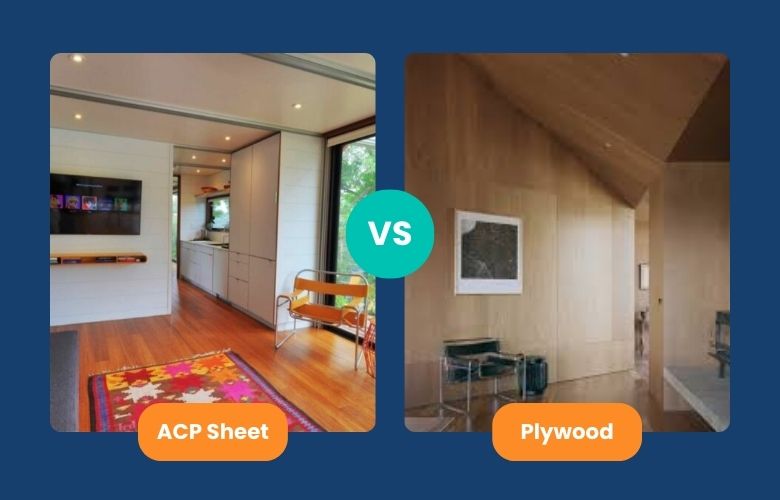ACP Sheets vs. Plywood: Which One Suits Your Needs Better?

ACP sheets and plywood are the two most loved and widely used in interiors across the globe for both commercial and residential projects. Both have different applications, properties, and benefits. Therefore, it becomes difficult to choose between these two while renovating or building a project from scratch.
Which one will complete your aesthetic desires or provide the necessary durability to your space decor? Find the answers to related questions in this blog. Here we have a detailed comparison between ACP sheets and plywood to find the perfect option for you.
A Detailed Comparison Between ACP Sheets and Plywood
Q 1: How They Differ In Material Composition?
ACP sheets are lightweight and strong because they are manufactured from an aluminium core. This contributes to greater durability and climatic resilience. The aluminium exterior of the fabric also protects it from UV rays and rust. In contrast, plywood comprises multiple thin wood veneer layers that may be compressed and fused together when heated and under stress.
Although plywood's composition provides strength and flexibility, it lacks the protective qualities of ACP sheets, making it more vulnerable to environmental degradation until properly addressed.
Q 2: Which One Is More Durable?
ACP Sheets are known for their exceptional durability. Because they are resistant to fading, corrosion, moisture, and harsh weather conditions making them suitable for both indoor and outdoor. The material no longer warps or swells in response to changes in humidity, guaranteeing long-term period balance.
Even though plywood is strong, it is more susceptible to termites, moisture, and wear, especially in humid areas. Plywood may swell or decay over time if the right solution is not used. Plywood still lacks the recognizable resilience of ACP Sheets, although it can provide exceptional durability when covered with protective coatings or sealants.
Q 3: Who Provides Better Versatility?
ACP Sheets offer versatility, along with different colourings, textures, and finishes. ACP Sheets offer loads of sleek and elegant aesthetic options, starting from bright and easy to matte and wood finishes. ACP Sheets are ideal for residential and industrial areas searching for modern-day designs due to their adaptability.
On the other hand, plywood adds a more conventional, rustic look. Although plywood can be painted, laminated, or veneered, it does not offer the identical stage of customisation or texture options as ACP Sheets. Rather than innovative ideas, plywood's enchantment is extra deeply anchored in traditional aesthetics.
Q 4: Which One Does Require Low Maintenance?
ACP Sheets are made of tremendously low-maintenance materials, requiring minimum upkeep over their lifespan. They are resistant to stains and fading. That means everyday cleaning is usually enough to keep them looking new. The lack of porosity in ACP Sheets allows for restricting mould buildup, making them a great option for areas with high humidity.
On the other hand, plywood requires extra maintenance. To shield against moisture and termites plywood desires periodic sealing and polishing. Without everyday protection, plywood can become worse, especially in excessive moisture environments. This can cause high-priced maintenance.
Q 5: Which One Is Cost-effective?
ACP sheets are generally more highly priced than plywood due to the advanced production method and the raw materials used. The price of ACP sheets can vary depending on the finish, thickness, and quality, but usually, it's a far better investment in the long term.
However, Plywood is budget-friendly and cost-effective, making it a popular choice for massive-scale programs, particularly in residential or low-cost commercial projects. Its low cost is attractive, yet, additional prices might also rise for maintenance and upkeep.
Q 6: Which One Is Easy To Install?
Installing ACP Sheets is fairly easy and quick. The lightweight nature of the ACP Sheets approach requires much less hard work and effort for set up, and they may be without difficulty cut to fit the favoured dimensions. They are usually fixed onto partitions and the use of screws makes installation straightforward and much less time-ingesting.
Plywood installation can be more extensive. It may additionally require extra cutting, shaping, or finishing to acquire the desired appearance. Professional installation is required if it needs to be dealt with for moisture or pest resistance. Plywood set-up can also take longer, especially in large areas, because the material needs extra precision and care at some point of installation.
Q 7: Which One Is Eco-Friendly?
ACP Sheets are eco-friendly compared to plywood because their production process uses aluminium and synthetic materials. ACP Sheets are recyclable and their manufacturing entails better power consumption and can make contributions to environmental welfare. However, if not disposed of responsibly it can cause damage to the environment.
Plywood, being a wooden-based material, is more environmentally sustainable when sourced from licensed forests. It is biodegradable and can be repurposed or recycled in many cases. However, the adhesives and treatments utilized in plywood production can reduce its eco-friendliness. Overall, plywood has a smaller environmental footprint in comparison to ACP sheets, especially when sustainably sourced.
Wrap Up
In summary, both the decor materials have their own advantages and disadvantages. If you are looking for modern aesthetics with durability, ACP sheets are the perfect match for you. Explore a luxurious range of ACP sheet collections by downloading our catalogue.

Leading ACP Sheet Manufacturer
As a proud representative of Alumina ACP, a premier manufacturer of Aluminum Composite Panels, I bring a wealth of expertise in acp sheets and addressing diverse architectural needs with innovative solutions. Join me on this journey of exploration and discovery!